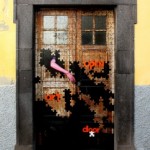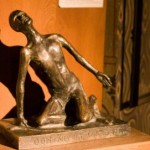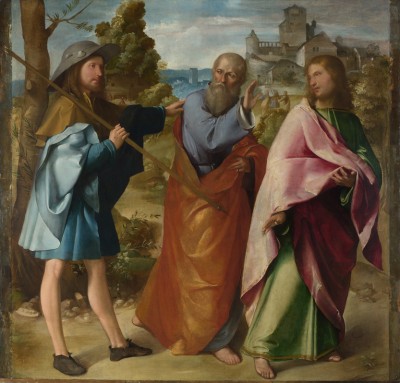 The Easter stranger appeared to three broken-hearted disciples who were getting out of Dodge. Jesus was dead. Everything in them was defiled by what they had seen, heard, done, left undone. For three days in the Upper Room they’d been holed up with the others, unable to agree what to do next. All their words, monotonous with defeat, were stale on their tongues. Even their grief was stagnant now. On Easter, these three went for a walk. They left town, on the Emmaus Road.
The Easter stranger appeared to three broken-hearted disciples who were getting out of Dodge. Jesus was dead. Everything in them was defiled by what they had seen, heard, done, left undone. For three days in the Upper Room they’d been holed up with the others, unable to agree what to do next. All their words, monotonous with defeat, were stale on their tongues. Even their grief was stagnant now. On Easter, these three went for a walk. They left town, on the Emmaus Road.
The stranger, who insisted on walking with them, was upbeat. Good Lord, was he totally unaware what had happened? He asked, and they told him. It took hours, because he kept arguing with them about what it all meant.
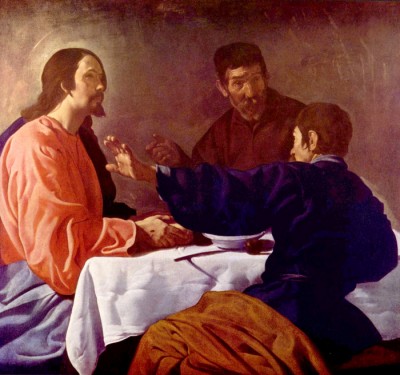 Despite that, they liked him. At the end of the day, when they found he was stopping at the same Inn, they asked him to dine with them. Then, in a wordless gesture, breaking bread, they saw in him – Jesus – alive – God with them still.
Despite that, they liked him. At the end of the day, when they found he was stopping at the same Inn, they asked him to dine with them. Then, in a wordless gesture, breaking bread, they saw in him – Jesus – alive – God with them still.
Suddenly nothing could keep them from running back to Jerusalem, to the others, to the Upper Room, which had become a green pasture again. No longer stale, the air in it was fragrant with Easter.
The Emmaus Road had been their Ark. It bore them over the wild tides of their own emotions, through the storm of days about which they argued, revealing the rainbow love of God at the day’s end. And then it delivered them safely back to Jerusalem, now the place where life for them could begin anew. Jesus, the helmsman of their journey, kept them on course in the sea of conversation.
Life ever since, for Christians, has been an Emmaus Road, a scary journey, extraordinary, arduous, full of argument and strangers, a conversation that reveals, transforms, prepares, and goes way beyond words.
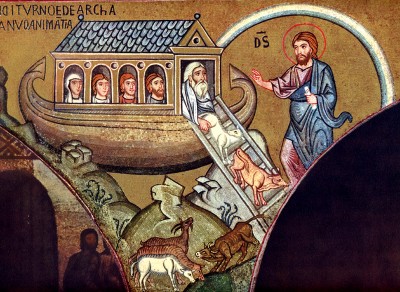 The Ark should be a model for our understanding of church. But in the new movie, Noah, it is anything but that. The movie tells an unbiblical story in which the entire argument is inside the helmsman, Noah, who makes everyone else miserable in God’s name, while the animals, who should be part of this strange conversational voyage, are drugged in stupor.
The Ark should be a model for our understanding of church. But in the new movie, Noah, it is anything but that. The movie tells an unbiblical story in which the entire argument is inside the helmsman, Noah, who makes everyone else miserable in God’s name, while the animals, who should be part of this strange conversational voyage, are drugged in stupor.
The biblical tale says Noah and his sons and their wives and families were on board. No unmarried son whose sweetie is rejected by Noah is mentioned. And there is no stowaway heathen psychopath. And no mention of drugged animals. Part of the wonder of the biblical tale is how those forty days went, how they all got along, who said what to whom. Forty days is what the Bible says it took.
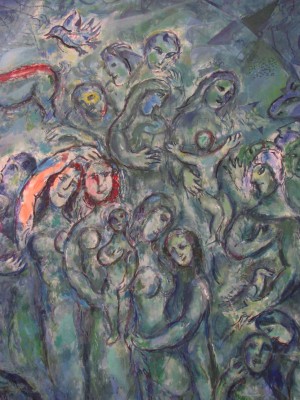 Part of the horror of the movie is that the journey is more than nine months, long enough for a pregnancy and delivery of twins, the only children on the Ark. But the real horror of the film is that Noah believes God wants to destroy humankind.
Part of the horror of the movie is that the journey is more than nine months, long enough for a pregnancy and delivery of twins, the only children on the Ark. But the real horror of the film is that Noah believes God wants to destroy humankind.
The biblical Noah, like Jesus on to road to Emmaus, is intent on cherishing the lives and souls of those he accompanies, intent on delivering them safely, in body and in spirit, to the green pastures of new life. The biblical Noah is upset about social corruption, and he does make his views known, but he is not out to destroy the world.
The movie hauls up the ideology of the old eugenics movement, champions of racial purity and physical ideals which gave us Hitler and the Ku Klux Klan. The movie claims Noah and his sons are the last remaining children of Seth, the ‘pure’ son of Adam and Eve, and that all other humans are children of Cain, who murdered Abel. The movie Noah intends to destroy his own grandchildren because his son’s wife is of impure blood.
For Christians, this is morally intolerable thinking, obscene thinking. The Bible does not identify Noah as of purer blood than anyone else, and in fact tells us he had brothers and sisters, nieces and nephews who didn’t come along. The rest of the people in his community thought he was nuts to build this boat, and disbelieved a flood was coming. Noah did not forbid them to enter the Ark. They stayed away from the old fool.
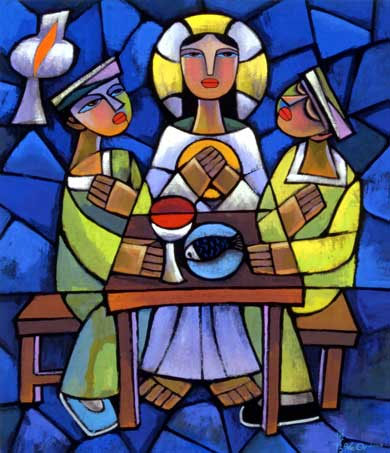 In the Bible, Helmsman Noah preserves the world, so that it will not perish, but have everlasting life. Jesus, Helmsman on the Emmaus Road, did this too, in a corrupt time.
In the Bible, Helmsman Noah preserves the world, so that it will not perish, but have everlasting life. Jesus, Helmsman on the Emmaus Road, did this too, in a corrupt time.
The Jewish Scriptures say Noah brought trees and seeds as well as animals on the Ark. French Jewish painter Marc Chagall painted a large community of people on the Ark, Noah’s family being numerous in his view.
It is the community of strangers journeying together that makes the Ark a home, a cradle, and a deliverance. And this is true of the Emmaus Road as well. On this road, strangers find one another, cradle one another’s pain, share stories and what they may mean, deliver one another by finding the presence of God together. And so they do in the Ark, finding the rainbow of God. In the Bible, the Ark is a ship of hope, a community of the awakened.
On the Emmaus Road the disciples were brought back to life. Their hearts, drugged with the poison of despair, were wakened by the Stranger who accompanied them. We hope for as much, and that the journey will take us, at last, to the rainbow.
__________________________________________________
Illustrations:
1. On the Emmaus Road, by Melone, Altobello, 1483 – 1565, National Gallery, London. Vanderbilt Divinity School Library, Art in the Christian Tradition.
2. The Inn at Emmaus, by Diego Velasquez, 1618, Metropolitan Museum of Art, New York. Vanderbilt Divinity School Library, Art in the Christian Tradition.
3. God Orders Noah to Leave the Ark. Capella Palatina di Palermo, Italy. Vanderbilt Divinity Library, Art in the Christian Tradition.
4. Noah’s Ark, by Marc Chagall, 1893 – 1985. Musee du Message Biblique, Nice, France. Vanderbilt Divinity School Library, Art in the Christian Tradition.
5. Supper at Emmaus. He Qi, China. 2001. Vanderbilt Divinity School Library, Art in the Christian Tradition.



